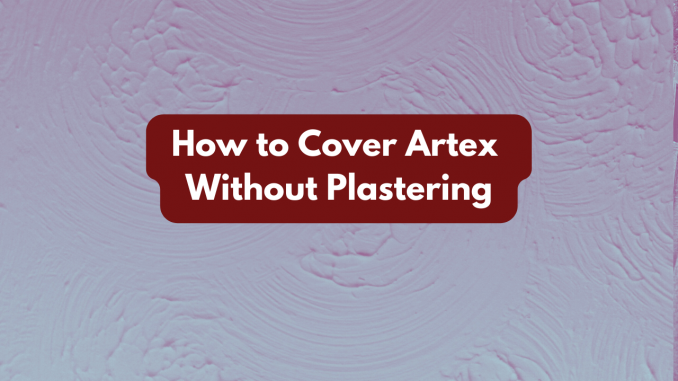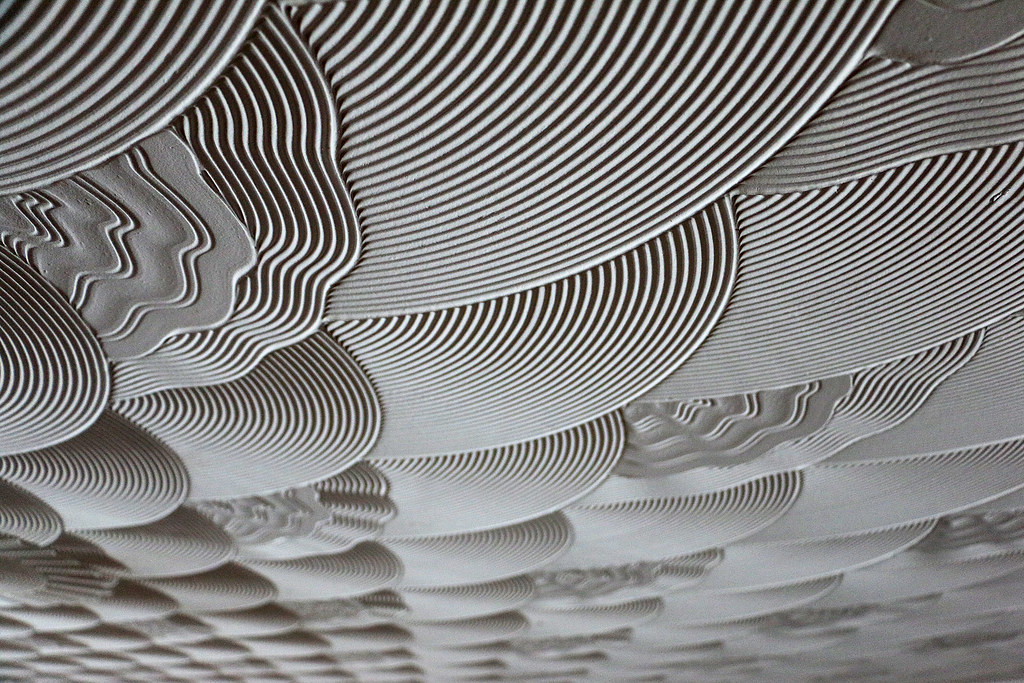
Covering Artex without plastering it can be challenging, as Artex is a textured surface that may show through certain coverings. However, there are a few options you can consider to hide or minimise the appearance of Artex on your standard uk ceiling without plastering .
Here are the easier options:
Textured Wallpaper: Look for heavy-duty textured wallpaper specifically designed to cover uneven surfaces like Artex. The texture of the wallpaper can help to mask the underlying Artex and create a more uniform look.
Lining Paper: Apply lining paper over the Artex. Lining paper is a thick, plain wallpaper that can help to smooth out the surface and provide a base for further decoration, such as painting or applying standard wallpaper.
Wooden Panelling: Install wooden panelling directly over the Artex. The panelling will cover the textured surface and provide a new, smooth finish.
PVC Wall Panels: PVC wall panels are another option for covering Artex. These panels are easy to install and can be affixed directly over the existing texture.
Drywall Overlays: Install drywall or plasterboard directly over the Artex. This method involves fixing the drywall sheets on top of the textured surface and then finishing the joints and seams. Keep in mind that this approach may add thickness to the walls, especially if you are painting the plasterboard, so check for sufficient space around doors, windows, and other elements.
Sanding and Filling: If the Artex texture is not too pronounced, you can try sanding down the high points to create a flatter surface. After sanding, apply a filler to any remaining indents or rough areas before finishing with paint or another covering.
Covering with Fabric: For a unique and creative option, you can cover the Artex with fabric. Use fabric adhesive or starch to adhere the fabric to the wall or ceiling, creating a soft, textured look.
Keep in mind that these methods may not completely eliminate the appearance of Artex, especially if the texture is deep or pronounced. Before proceeding, it’s essential to assess the condition of the Artex and ensure that it does not contain any hazardous materials, such as asbestos, especially in older installations.

Guide to covering Artex without Plastering
If you are able and confident in having a go at covering Artex without plastering, here are the steps to follow:
Steps to covering Artex without plastering:
- Clean the surface – Start by cleaning the Artex surface thoroughly to remove any dust, dirt, or grease. Use a mixture of warm water and mild detergent, and scrub the surface gently with a sponge or cloth. Allow it to dry completely before proceeding.
- Fill in the texture – Use a filler or joint compound to fill in the textured surface of the Artex. Apply the filler generously over the textured areas, using a putty knife or a trowel. Smooth it out as much as possible, trying to level the surface. Let the filler dry completely according to the manufacturer’s instructions.
- Sand the filled areas – Once the filler is dry, use fine-grit sandpaper to sand down the filled areas until they are smooth and level with the surrounding surface. This step is crucial for achieving a seamless finish.
- Prime the surface – Apply a coat of primer to the entire surface, including the filled areas. Primer helps to seal the surface and provides a better adhesion for the topcoat. Allow the primer to dry completely before proceeding.
- Paint or wallpaper – Depending on your preference, you can either paint the surface or apply wallpaper over it. If you choose to paint, apply at least two coats of paint for an even finish, allowing each coat to dry completely between applications. If you opt for wallpaper, follow the manufacturer’s instructions for application.
- Finish – Once the paint or wallpaper is dry, inspect the surface for any imperfections. Touch up any areas as needed and ensure that the finish is uniform and smooth.
By following these steps, you can effectively cover Artex without plastering, providing a fresh and updated look to your walls or ceiling.
If you’re uncertain about how to proceed or have concerns about the underlying condition of the Artex, it’s advisable to consult with a professional contractor or interior designer who can provide tailored advice based on your specific situation.
What is an Artex Ceiling?
Artex is a water-based textured coating that was commonly used as a decorative finish for interior walls and ceilings. It was particularly popular in the 1970s and 1980s. The term “Artex” is also used as a brand name by Artex Ltd, a company that originally manufactured this type of coating.
Artex was applied to surfaces using various techniques, such as using a brush, roller, or more commonly, by using a special comb-like tool that created patterns and textures. The resulting texture added visual interest to the walls and ceilings, hiding imperfections and providing a unique, decorative appearance.
The texture patterns created by Artex could range from simple swirls and stippled designs to more complex patterns. It was available in various colors, allowing homeowners to match the Artex finish with their interior decor.
While Artex was widely used in the past, its popularity has waned over the years. This is due, in part, to changing interior design trends and a preference for smoother, more minimalist finishes. Additionally, there were concerns regarding asbestos content in some older versions of Artex, leading to its decline in usage.
Is there Asbestos in Artex?
Asbestos was sometimes used as a component in the earlier versions of Artex to enhance its properties, but it was phased out when the health risks associated with asbestos became widely known. Modern versions of textured coatings like Artex typically do not contain asbestos.
Keep in mind that interior design trends and product availability may have changed since my last update in September 2021, so it’s advisable to check with local suppliers or professionals for the most up-to-date information on textured coatings like Artex.
Questions regarding Asbestos & Artex
Asbestos in Artex ceilings can be a concerning issue due to the health risks associated with asbestos exposure. Here are some common frequently asked questions (FAQs) related to asbestos in Artex ceilings:
What is Artex?
Artex is a textured coating that was commonly used on ceilings and walls for decorative purposes in the past. It can contain asbestos fibers, particularly in older formulations.
Is asbestos in Artex dangerous?
Yes, asbestos in Artex can be dangerous if it becomes airborne. Inhaling asbestos fibers can lead to serious health issues, including lung cancer, asbestosis, and mesothelioma.
How can I tell if my Artex ceiling contains asbestos?
The only way to definitively determine if your Artex ceiling contains asbestos is to have it tested by a qualified asbestos professional. Visual inspection alone is not enough, as asbestos fibers are microscopic and not visible to the naked eye.
When was asbestos commonly used in Artex?
Asbestos was commonly used in construction materials, including Artex, until the late 20th century. Its use declined significantly after the health risks associated with asbestos exposure became well-known.
Is it safe to live in a house with Artex ceilings that may contain asbestos?
If the Artex ceilings are intact and not damaged, they may not pose an immediate health risk. However, it’s important to monitor their condition and consider professional testing if you plan to renovate or make any changes that could disturb the material.
Should I remove asbestos-containing Artex myself?
No, it is not safe to remove asbestos-containing Artex yourself. Asbestos removal should only be performed by trained and licensed asbestos professionals who have the necessary equipment and expertise to handle asbestos safely.
Can you wallpaper over Artex?
Yes, you can wallpaper over Artex, but it requires preparation to achieve a smooth finish. Artex is often textured, so the surface must be cleaned and levelled before applying wallpaper. Minor textures can be smoothed with filler, while more pronounced patterns may need to be skimmed with a layer of plaster or covered with lining paper.
Ensure the surface is clean, dry, and stable, as wallpaper won’t adhere properly to loose or crumbly Artex. Always test a small area first and consider consulting a professional if the texture is particularly deep or if the Artex contains asbestos, which was common in older homes.
What should I do if I suspect my Artex ceiling contains asbestos?
If you suspect your Artex ceiling contains asbestos, it’s important to contact a licensed asbestos professional for testing and evaluation. They can advise you on the best course of action, which may include encapsulation, sealing, or removal if necessary.
How much does asbestos removal from Artex ceilings cost?
The cost of asbestos removal can vary widely depending on factors such as the extent of contamination, location, and the complexity of the removal process. It’s essential to obtain quotes from licensed asbestos removal companies for accurate pricing.
Are there any regulations regarding asbestos in Artex ceilings?
In the UK, you must comply with Managing and working with asbestos: Control of Asbestos Regulations 2012
What are the health risks of asbestos exposure from Artex ceilings?
Health risks associated with asbestos exposure from Artex ceilings include respiratory problems, lung cancer, asbestosis, and mesothelioma. These diseases can develop years or even decades after exposure.
DISCLAIMER: Remember that dealing with asbestos is a serious matter, and safety precautions should always be a top priority. Consult with professionals and follow recommended procedures when handling asbestos-containing materials like Artex ceilings.

Leave a Reply